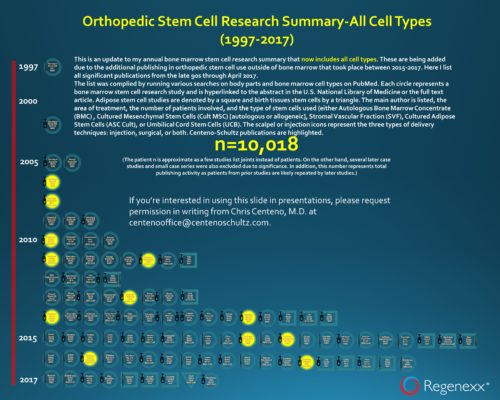My New Annual All Stem Cell Type Orthopedic Infographic
As I promised yesterday, for the first year ever, I have updated my orthopedic stem-cell-research infographic to include other stem cell sources outside of bone marrow. It’s exciting to finally have enough data on fat to believe that it will be a factor in what’s best for orthopedic patients.
(Click here for a larger view)
My Issues with Fat
The biggest long-term problem I have had with the use of fat stem cells to treat orthopedic conditions has been the lack of data. The animal data wasn’t all that convincing, and little human data existed. In 2015 and 2016 that began to change as I noted several papers being published. Hence, it was time to declare that fat stem cells may have a place alongside bone marrow in orthopedic care.
What’s New in Orthopedic Fat-Stem-Cell Research?
Most of the published fat-stem-cell studies are on knee arthritis with some publishing on the ankle. More importantly, almost all high-quality studies are out of Korea. So just as the U.S. has lost the orthopedic bone-marrow-stem-cell lead to Spain, in fat stem cells, it’s losing to the Koreans. How is it possible that we as a country have funded 100X or more basic-science stem cell research than the Koreans and that they are trouncing us in clinical studies? Their version of the FDA has allowed fat stromal vascular fraction (SVF or a same-day fat-stem-cell procedure), whereas ours has considered it a drug. While this hasn’t stopped many clinics from floating the regulatory risk, it’s clear that separating stem cells from fat is illegal in the U.S.
How Does the Fat-Stem-Cell Research Stack Up Against Bone Marrow?

The graphs to the left show that bone marrow research in orthopedics still dominates the landscape. This is based both on a comparison of the number of papers as well as the number of patient results reported. It should also be noted that the largest stem cell paper on fat used outcome measures that were mostly determined by the providers and not the patients. It should also be pointed out that this is the only paper that used a US legal fat graft alongside the US illegal SVF. That study found no difference in outcome between SVF and a fat graft.
How Do You Use This Document?
First, click on the image above to see a live PDF. Second, each circle, square, and triangle above are a link to the study listed. The circles are bone marrow studies, the squares are fat based, and the triangle represents birth tissues (in this case cord-blood stem cells). Inside those shapes, you’ll find the author’s name, body-area focus of the study, the number of treated patients, and then the type of cells used. Please notify me if I’ve missed any studies because all of this is based on multiple PubMed searches. Also, if you catch a bad link, please drop me a line as well. The e-mail address that goes to my desk is [email protected].
The upshot? Fat fans, welcome to the stem cell research world! Many people thought I was anti-fat, yet for me it’s all about the research. So as the new studies rolled in, it’s clearly time to move from an annual bone-marrow-stem-cell-research infographic to an all-cell-type orthopedic-stem-cell-research infographic!
Adipose Grafts
If you have questions or comments about this blog post, please email us at [email protected]
NOTE: This blog post provides general information to help the reader better understand regenerative medicine, musculoskeletal health, and related subjects. All content provided in this blog, website, or any linked materials, including text, graphics, images, patient profiles, outcomes, and information, are not intended and should not be considered or used as a substitute for medical advice, diagnosis, or treatment. Please always consult with a professional and certified healthcare provider to discuss if a treatment is right for you.
